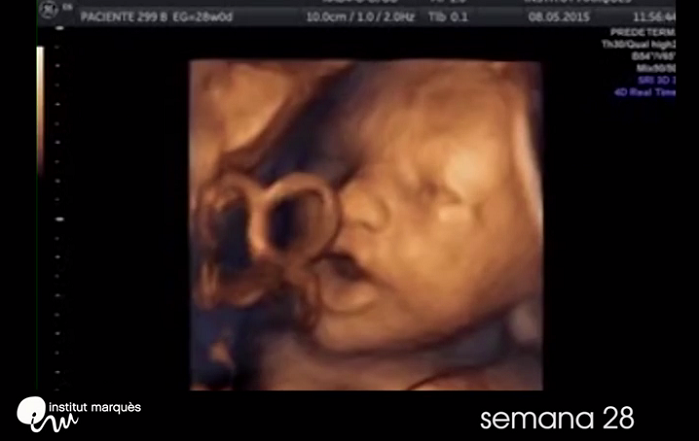A new Ohio law takes effect today that bans late-term abortions on unborn babies after 20 weeks. The law is designed to protect unborn children who research shows feel excruciating pain during abortion procedures.
Last month, Governor John Kasich signed the Pain-Capable Unborn Child Protection Act (Sub. S.B. 127), landmark legislation which would ban late-term abortions after 20 weeks of pregnancy.
“I agree with Ohio Right to Life and other leading pro-life advocates that SB 127 (a 20-week ban) is the best, most legally sound and sustainable approach to protecting the sanctity of human life,” Kasich said in a statement.
At twenty weeks, the child has all the parts in place – the pain receptors, spinal cord, nerve tracts, and thalamus – needed for transmitting and feeling pain.
The unborn child responds to touch as early as week six, and by week eighteen, pain receptors have appeared throughout the child’s body.
“The thalamus which is the center of pain consciousness in the brain develops during weeks eight through sixteen, and the nerve tracts connecting the spinal cord and thalamus are themselves in place by week 20,” says Randy O’Bannon of National Right to Life. “Like infants, the unborn child cannot speak and describe his or her pain experience, but there are the usual physiological indicators that indicate pain awareness.”
“As early as eighteen weeks, an unborn child injected with a needle releases stress hormones, just as adults do when experiencing pain. Hormone levels in those babies decrease when pain-relievers are supplied,” he added. “Studies indicate that anencephalic infants, whose cortex is severely reduced if not altogether absent, experience pain as long as other neurological structures are functioning.”
Though abortion advocates deny the science of fetal pain, researchers have fully established fetal pain at 20 weeks or earlier. Dr. Steven Zielinski, an internal medicine physician from Oregon, is one of the leading researchers into it. He first published reports in the 1980s to validate research showing evidence for unborn pain.
SUPPORT LIFENEWS! If you like this pro-life article, please help LifeNews.com with a donation!
He testified before U.S. Congress that an unborn child could feel pain at “eight-and-a-half weeks and possibly earlier” and that a baby before birth “under the right circumstances, is capable of crying.”
Dr. Colleen A. Malloy, a professor of neonatology at Northwestern University’s Feinberg School of Medicine, told a Senate committee last year that “anesthesiologists, and surgeons use pain medication” at the 20 week stage, “because it’s supported by the literature completely.”
“The standard of care for NICUs requires attention to and treatment of neonatal pain,” she said. “There is no reason to believe that a born infant will feel pain any differently than that same infant if he or she were still in utero.”
“I could never imagine subjecting my tiny patients to a horrific procedure such as those that involve limb detachment or cardiac injection,” Malloy added.
A national poll by The Polling Company found that, after being informed that there is scientific evidence that unborn children are capable of feeling pain at least by 20 weeks, 64% would support a law banning abortion after 20 weeks, unless the mother’s life was in danger. Only 30% said they would oppose such a law.
The pro-life group Ohio Right to Life thanked Kasich for signing the 20-week ban — saying it would save hundreds of babies from abortions.
“On behalf of Ohio Right to Life and our statewide members, we sincerely thank Governor Kasich for his unwavering support for the unborn and our pro-life mission. By signing S.B. 127, the 20-week ban, Governor Kasich will save hundreds of unborn lives each year and he positioned the state of Ohio to directly challenge Roe v. Wade,” it told LifeNews. “The 20-week ban was nationally designed to be the vehicle to end abortion in America. It challenges the current national abortion standard and properly moves the legal needle from viability to the baby’s ability to feel pain.”
“Given the current make-up of the United States Supreme Court, Governor Kasich got it right by embracing the strategic incremental approach to ending abortion. Pro-life Ohioans are proud to have his support as a super majority of Republicans and Democrats within the General Assembly voted to support the 20-week ban. At no time in our state’s history have we had such protective pro-life laws, and we have Gov. Kasich and our pro-life legislature to thank,” the group added.
“Ohio Right to Life supports Governor Kasich’s decision to bypass the heartbeat legislative approach at this time. While it must have been difficult, the current make-up of a radically pro-abortion Supreme Court required the Governor to exercise great restraint. Further, filling the current vacancy on the Court by our next President will still leave the court with a pro-abortion majority,” Ohio Right to Life continued.








